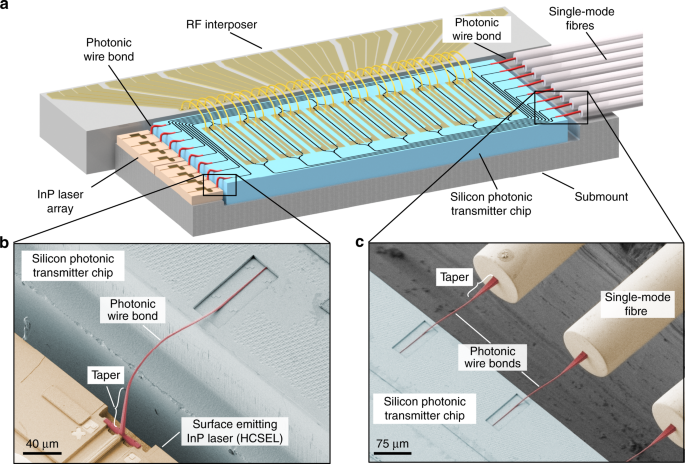PHOTONIC INTEGRATED CIRCUITS
A photonic integrated circuit (PIC), also known as an integrated optical circuit, is a device that combines numerous (at least two) photonic functions, comparable to an electronic IC. A PIC provides functionality for information signals imposed on optical wavelengths commonly in the visible spectrum or near-infrared (850 nm-1700 nm). In 2005, an issue with quantum noise emerged during the development of laser light through silicon in an electronic integrated circuit, preventing the generation. This challenge was easily solved by a photonic integrated circuit, which produced laser light within the circuit as a single medium and at a higher bandwidth. As a result, the significance of PIC was recognised.
Comparison to electronic integration
The primary distinction between PICs and Electronic ICs is the type of material employed in their manufacture. Silicon is the most common material used in electronic ICs. However, in the case of PIC, the fabrication material is primarily determined by the device’s purpose. That is, the material will be determined by the device’s intended function. For example, silica (silicon dioxide) based PICs have very desirable properties for passive photonic circuits such as AWGs due to their comparatively low losses and low thermal sensitivity, GaAs or InP based PICs allow direct integration of light sources, and Silicon PICs allow photonics and transistor-based electronics to be integrated together.
Take a look at a GaAs-InP Photonic integrated circuit.

Fabrication Methods
Both devices are made using the same techniques. The etching and material deposition procedures used in photolithography are the same. The fundamental difference is in the fabrication device itself. The transistor is the most important component in an electronic IC. However, there is no single main device that dominates the fabrication in PIC. The ranges of fabrication devices vary depending on the application, as the devices to be integrated are larger than those utilised in an electronic integrated circuit. Optical amplifiers, filters, low loss-high efficiency interconnect waveguides, detectors, power splitters, modulators, and lasers are among the devices. The techniques and steps get more challenging as different materials are required to build all of these devices on a single chip. However, utilising the resonant photonic interferometry process, researchers have recently devised methods to create PICs. We can simply and cheaply develop ultraviolet light-emitting diodes (LED) using this technology. We can easily overcome optical computing issues by using such LEDs.
Photonic Integration Methods
There exists mainly two kinds of photonic integration methods. They are
- Hybrid Photonic Integration
- Monolithic Photonic Integration
The developed integrated IC for Hybrid Photonic Integration will be a single package. This kit will include several photonic devices that all do the same task. Because of this benefit, many ICs are produced using this technology in order to combine a large number of integrated optic devices.

Monolithic Photonic Integration combines a number of optical devices with distinct functions to build a single integrated circuit. The construction of such a gadget will be difficult due to the large number of materials required. To manufacture and integrate onto a common substrate, all of these materials must be fabricated. As a result, a single chip can perform multiple functions.

Applications of Photonic Integrated Circuits
Externally Modulated Lasers (EML) which combine a distributed feedback laser diode with an electro-absorption modulator on a single Indium-Phosphide [InP] chip, are used in fibre-optic communication. It has a lot of potential in Wavelength Division Multiplexed (WDM) fibre-optic communication systems, where an Arrays Waveguide Grating (AWG) must be constructed. Optical multiplexers and demultiplexers often use AWG. Biomedical and photonic computing applications Optical sensors and metrology are examples of applications.
Advantages of Photonic Integrated Circuits
The employment of optical devices helps to make the entire system more discreet, small, and high-performing. The chip can also be integrated with simple electronic circuits, allowing it to perform a wider range of tasks. Though rare, the neutron flux impact can harm PICs, causing some of their functionalities to be lost. When it comes to the effects of electromagnetic pulse [EMP], however, there will be no issues like there are with electrical ICs. Future This technology has not yet reached its pinnacle of development. People are working to make this technology more common, low-cost, and efficient through continuous study. However, practically all electronic ICs will be replaced by PICs in the future. There may also be instances where both electronics and optics can be integrated.
